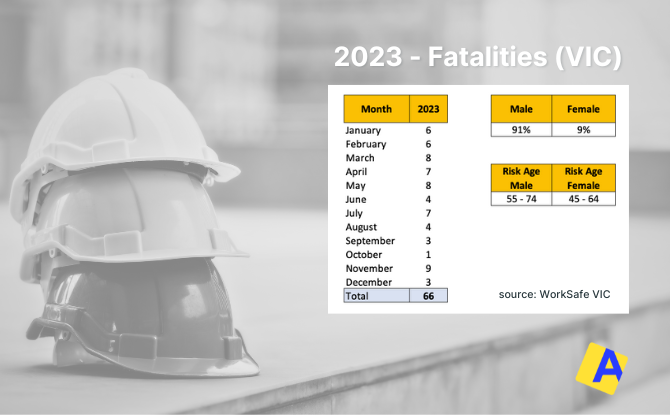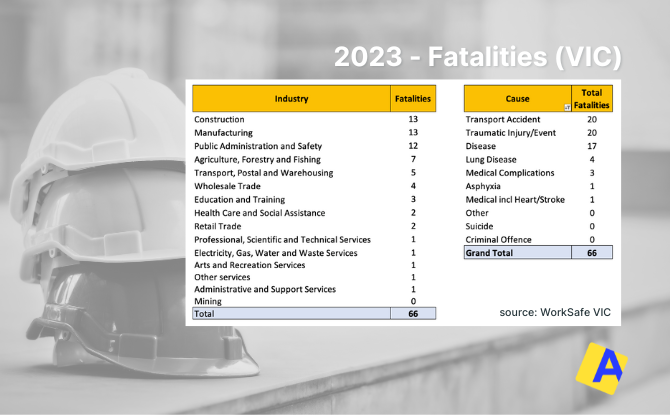Dealing with the aftermath of a workplace fatality is one of the most challenging situations any business can face. It’s not just about compliance—it’s about the people, the hearts and minds of those who count on a safe workplace every day. Beyond the immediate response and investigation, every business must focus on recovery, compliance, support, and fostering resilience. But most importantly, we need to ask: If a fatality occurs at your workplace tomorrow, do you know what to do? Or What is the right thing to do?
In 2023, Victoria reported 66 confirmed workplace fatalities, highlighting the critical need for continuous vigilance in safety practices. But beyond the numbers are real people who went to work expecting to return home safely. As business leaders, we share the responsibility of protecting them.
Trends in Workplace Fatalities
A closer examination of the data reveals some concerning trends that underline the importance of reinforcing safety not only during designated periods like National Safe Work Month in October but also maintaining a year-round commitment to our people.

A Spike After Safety Month: Alarmingly, the highest number of fatalities (9 in total) occurred in November—just one month after National Safe Work Month. While October raises awareness, these figures show that safety campaigns alone aren’t enough. Are your safety practices sustained throughout the year, or does the focus fade after the push for compliance?
Older Workers at Risk: The data also reveals that 91% of fatalities were males, particularly those aged between 55 to 74 years. For females, the most at-risk age group was between 45 to 64 years old. Older workers face unique risks, this could be due to a variety of factors, including the nature of their roles, physical capabilities, and possibly less adaptation to newer safety technologies or practices.
Is your people properly supported with up-to-date safety measures, or are they being left behind?
Fatalities by Industry: Where the Risks Are Highest
Some industries bear more risk than others, and that’s reflected in the fatality data for 2023:

Construction and Manufacturing: These industries, which recorded 13 fatalities each, are inherently dangerous. Heavy machinery, heights, and hazardous environments put workers at constant risk.
Public Administration and Safety: With 12 fatalities, public safety roles carry unpredictable risks that can be hard to foresee.
Are your industry-specific protocols enough to protect your people, or is there room for improvement?
Transport Accidents and Traumatic Injuries/Events: Each accounted for 20 deaths. Vehicles and heavy machinery pose ever-present dangers in construction, agriculture, and manufacturing.
Occupational Disease: Seventeen deaths were due to disease, showing that long-term exposure to harmful conditions can be just as deadly as an accident.
Each fatality is more than a statistic—it’s someone’s loved one. Are you doing everything possible to prevent these tragedies from happening in your workplace?
Is your business prepared to face a challenging situation such as a fatality?
Are you prepared to take the right steps if the unthinkable happens at your workplace? Knowing what to do in the aftermath of a fatal incident is crucial, not only for legal compliance but also for honouring the people involved.
One of the most important steps is ensuring legal privilege. Legal privilege protects confidential communications and documents between a lawyer and a client, whether it’s for legal advice or litigation. But beyond that, it’s about ensuring you have the support needed to do the right thing for your people.
Here is a 10-step plan to help you Manage Workplace Safety After a Fatality.
1. Immediate Actions Post-Investigation
Once the investigation into the workplace fatality has concluded, businesses must ensure that all legal and procedural requirements have been fulfilled. From Reports and Communicating with stakeholders, to reviewing existing safety protocols.
Working with an Industry Expert can help you to discover new insights and optimise your safety plan. Contact us if you need assistance.
2. Providing Support to Employees
A fatality can have a profound impact on people, affecting their mental health, morale, and perception of safety at work. You need to be ready to provide the necessary support, including:
- Psychological Support and Counselling.
- Maintaining Open Communication.
- Offering Group Support Sessions.
3. Legal and Compliance Follow-Up
After addressing the immediate aftermath of a fatality, ensuring ongoing compliance with legal obligations is essential. Reviewing legal obligations and coordinate with legal teams is essential, but don’t forget about your people. Conducting regular Workplace audits will help you to ensure all corrective actions have been implemented effectively, fostering a safer environment for your workforce.
Working with a safety consultant can help ensure adherence to the latest codes of practice in your industry. Contact us if you need assistance.
4. Engaging with your workforce.
Moving forward isn’t easy, but as a leader you must take initiative to protect those who trust their lives to your business. Conducting strategic meetings to improve workplace safety, and promoting a Safety-First culture are adequate approach you may adopt.
You can also engage with a Safety Consultant to enhance your safety plan. Contact us if you need assistance.
5. Reviewing and Revising Safety Policies
Don’t rely only in your existing safety policies and procedures. Analyse incident data to identify gaps or weaknesses and develop training programs to educate and prepare your people.
Platforms like Safety Champion Software can help you identify trends, visualise high-risk incidents that need to be addressed, and deploy Training Programs.
6. Building Resilience in the Workplace
This is probably the most challenging step on our list. Building resilience is essential to helping your people recover from a traumatic incident and preparing them for future challenges.
Foster an environment where people feel supported, valued, and confident in their ability to overcome challenges. Managing Psychosocial is a great way to strengthen skills in stress management, communication, and adaptability, helping people to work on their mental health.
7. Enhancing Safety Training Programs
Continually improving safety training programs is vital to reinforce safety practices and prevent future incidents. Through regular and specialised training, drills, and simulations, you can prepare your people for emergency situations and teach them how to respond effectively.
8. Monitoring and Evaluating the Effectiveness of Safety Measures
Your people are your best source of feedback, so engage and involve them in the continuous improvement process. Conducting regular inspections and implementing Safety Metrics relevant to your business and industry can help you identify specific risks and develop strategies to mitigate them.
9. Communication Strategy for Moving Forward
A clear and effective communication strategy is essential to restore confidence and trust within your business. Address concerns from your employees, provide transparent updates and celebrate achievements to reinforce a positive safety culture.
10. Engaging with External Support and Resources
You may also consider engaging with external resources and support to enhance workplace safety. You can utilise Government Resources such as training materials, supporting programs, guidelines and codes of practice to stay updated on best practices and regulatory changes. You can also consult with safety experts to conduct in-depth audits or provide advice on improving your safety practices.
Are You Prepared?
As a business owner or operations manager, the question isn’t if you’re compliant—it’s if you’re truly prepared to protect your people.
Would you know what to do?, Would you be able to navigate the legal, emotional, and practical challenges of such a tragic event?
Let’s work together to ensure your workplace is not only safe but resilient.

